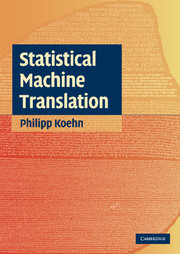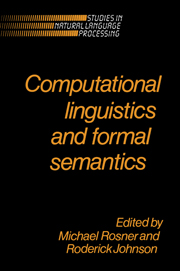Refine search
Actions for selected content:
3326 results in Artificial Intelligence and Natural Language Processing

Argumentation Schemes
-
- Published online:
- 05 June 2012
- Print publication:
- 04 August 2008

Statistical Machine Translation
-
- Published online:
- 05 June 2012
- Print publication:
- 17 December 2009

Computational Linguistics and Formal Semantics
-
- Published online:
- 05 June 2012
- Print publication:
- 30 October 1992

An Introduction to Many-Valued and Fuzzy Logic
- Semantics, Algebras, and Derivation Systems
-
- Published online:
- 05 June 2012
- Print publication:
- 14 January 2008
NLE volume 18 issue 3 Cover and Back matter
-
- Journal:
- Natural Language Engineering / Volume 18 / Issue 3 / July 2012
- Published online by Cambridge University Press:
- 25 May 2012, pp. b1-b8
-
- Article
-
- You have access
- Export citation
In Memoriam: David L. Waltz
-
- Journal:
- Natural Language Engineering / Volume 18 / Issue 3 / July 2012
- Published online by Cambridge University Press:
- 25 May 2012, p. 291
-
- Article
-
- You have access
- HTML
- Export citation
NLE volume 18 issue 3 Cover and Front matter
-
- Journal:
- Natural Language Engineering / Volume 18 / Issue 3 / July 2012
- Published online by Cambridge University Press:
- 25 May 2012, pp. f1-f2
-
- Article
-
- You have access
- Export citation
Reinhard Köhler. Quantitative Syntax Analysis. Mouton de Gruyter, Berlin/Boston, 2012, x + 224 pp., €99.95/US$ 140.00, ISBN: 978-3-11-027219-2
-
- Journal:
- Natural Language Engineering / Volume 19 / Issue 1 / January 2013
- Published online by Cambridge University Press:
- 14 May 2012, pp. 143-146
-
- Article
- Export citation
Statistical Translation After Source Reordering: Oracles, Context-Aware Models, and Empirical Analysis
-
- Journal:
- Natural Language Engineering / Volume 18 / Issue 4 / October 2012
- Published online by Cambridge University Press:
- 14 May 2012, pp. 491-519
-
- Article
- Export citation
Recent advances in methods of lexical semantic relatedness – a survey
-
- Journal:
- Natural Language Engineering / Volume 19 / Issue 4 / October 2013
- Published online by Cambridge University Press:
- 04 May 2012, pp. 411-479
-
- Article
- Export citation
Extraction of multi-word expressions from small parallel corpora
-
- Journal:
- Natural Language Engineering / Volume 18 / Issue 4 / October 2012
- Published online by Cambridge University Press:
- 21 March 2012, pp. 549-573
-
- Article
- Export citation
NLE volume 18 issue 2 Cover and Front matter
-
- Journal:
- Natural Language Engineering / Volume 18 / Issue 2 / April 2012
- Published online by Cambridge University Press:
- 14 March 2012, pp. f1-f2
-
- Article
-
- You have access
- Export citation
ERD-MedLDA: Entity relation detection using supervised topic models with maximum margin learning
-
- Journal:
- Natural Language Engineering / Volume 18 / Issue 2 / April 2012
- Published online by Cambridge University Press:
- 14 March 2012, pp. 263-289
-
- Article
- Export citation
Exploiting the Wikipedia structure in local and global classification of taxonomic relations*
-
- Journal:
- Natural Language Engineering / Volume 18 / Issue 2 / April 2012
- Published online by Cambridge University Press:
- 14 March 2012, pp. 235-262
-
- Article
- Export citation
NLE volume 18 issue 2 Cover and Back matter
-
- Journal:
- Natural Language Engineering / Volume 18 / Issue 2 / April 2012
- Published online by Cambridge University Press:
- 14 March 2012, pp. b1-b3
-
- Article
-
- You have access
- Export citation
Unsupervised dependency parsing without training†
-
- Journal:
- Natural Language Engineering / Volume 18 / Issue 2 / April 2012
- Published online by Cambridge University Press:
- 14 March 2012, pp. 187-203
-
- Article
- Export citation
Structure-guided supertagger learning
-
- Journal:
- Natural Language Engineering / Volume 18 / Issue 2 / April 2012
- Published online by Cambridge University Press:
- 14 March 2012, pp. 205-234
-
- Article
- Export citation
Document ranking refinement using a Markov random field model*
-
- Journal:
- Natural Language Engineering / Volume 18 / Issue 2 / April 2012
- Published online by Cambridge University Press:
- 14 March 2012, pp. 155-185
-
- Article
- Export citation
Special issue on statistical learning of natural language structured input and output
-
- Journal:
- Natural Language Engineering / Volume 18 / Issue 2 / April 2012
- Published online by Cambridge University Press:
- 14 March 2012, pp. 147-153
-
- Article
-
- You have access
- HTML
- Export citation
On morphological relatedness
-
- Journal:
- Natural Language Engineering / Volume 19 / Issue 4 / October 2013
- Published online by Cambridge University Press:
- 10 February 2012, pp. 537-555
-
- Article
- Export citation
